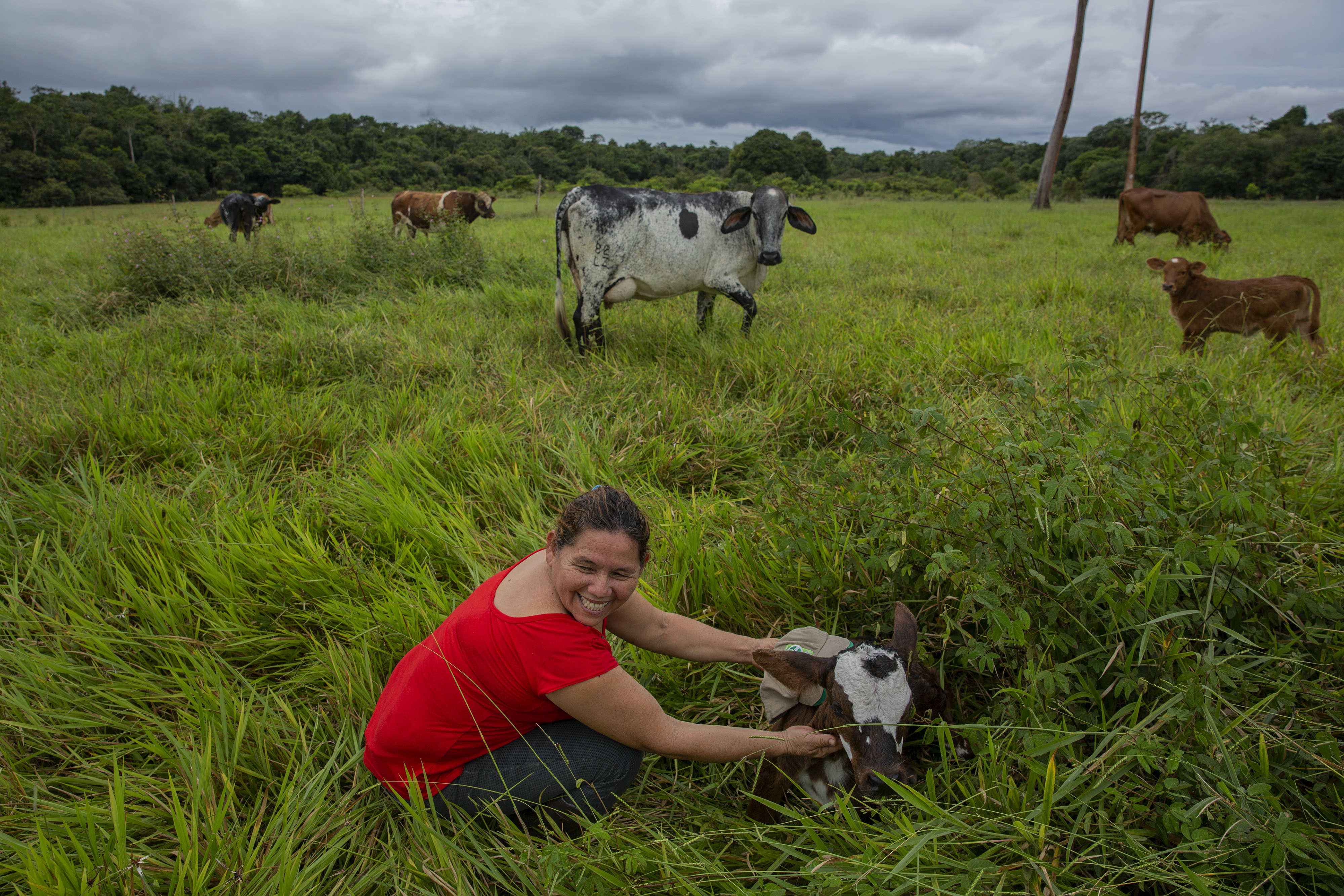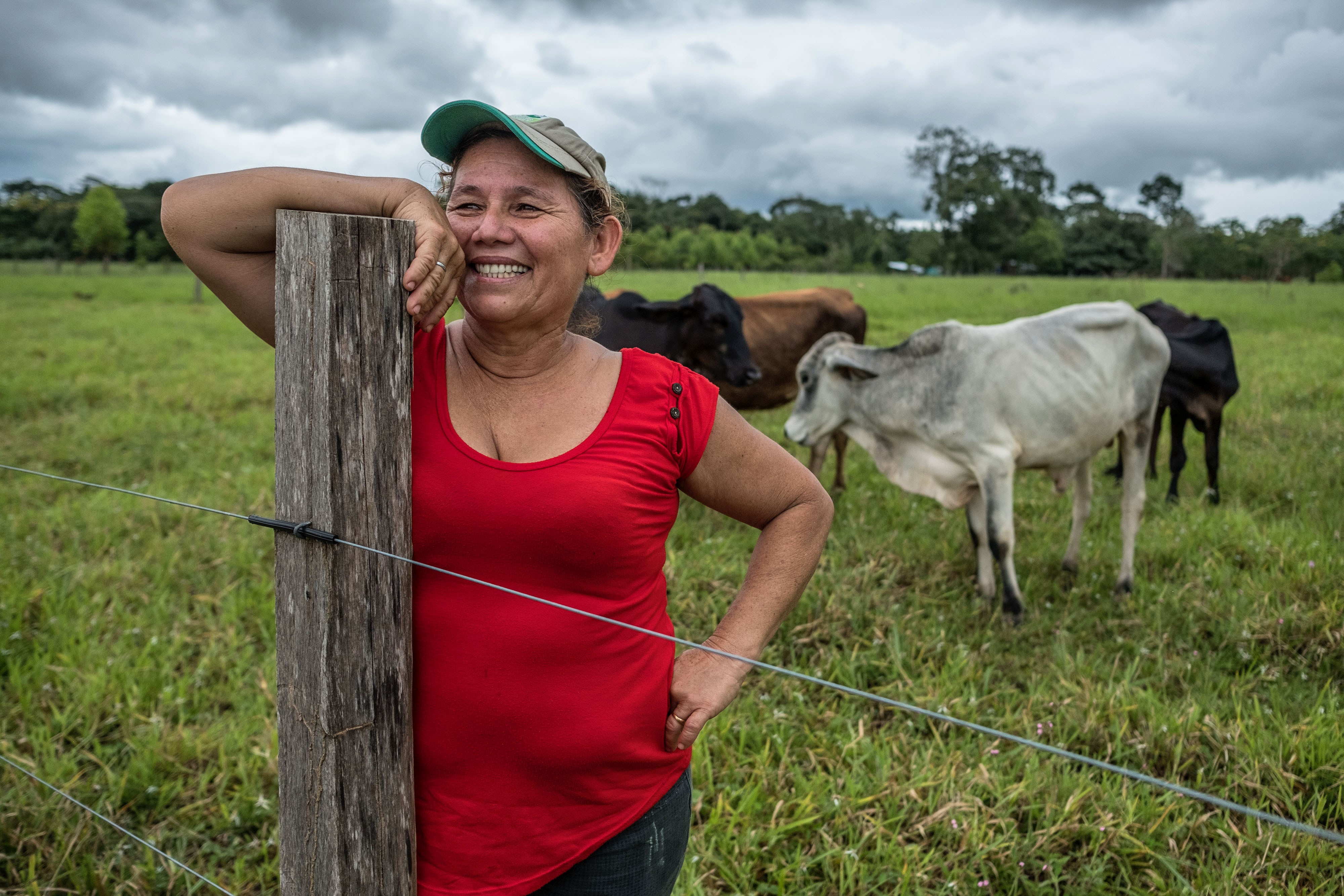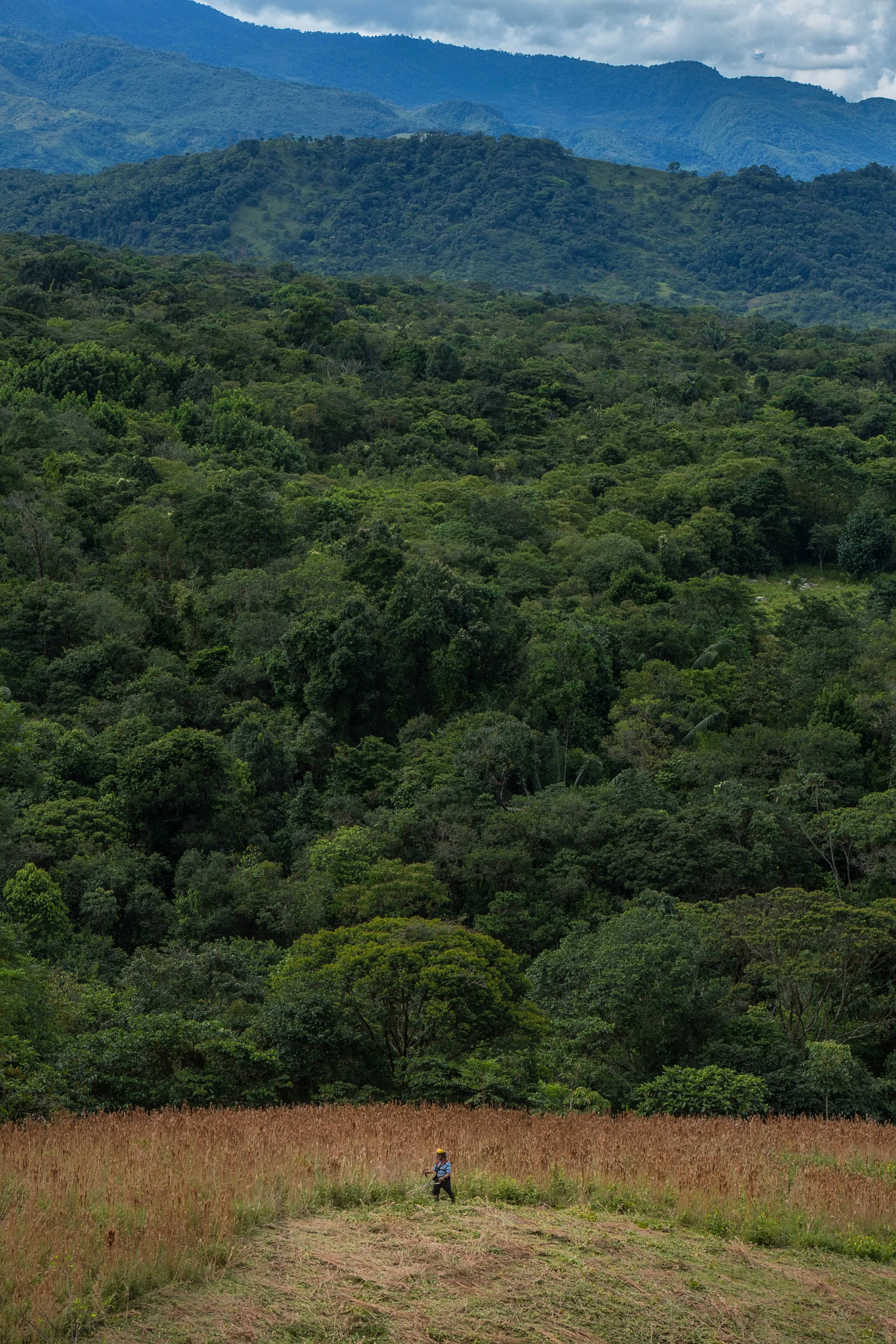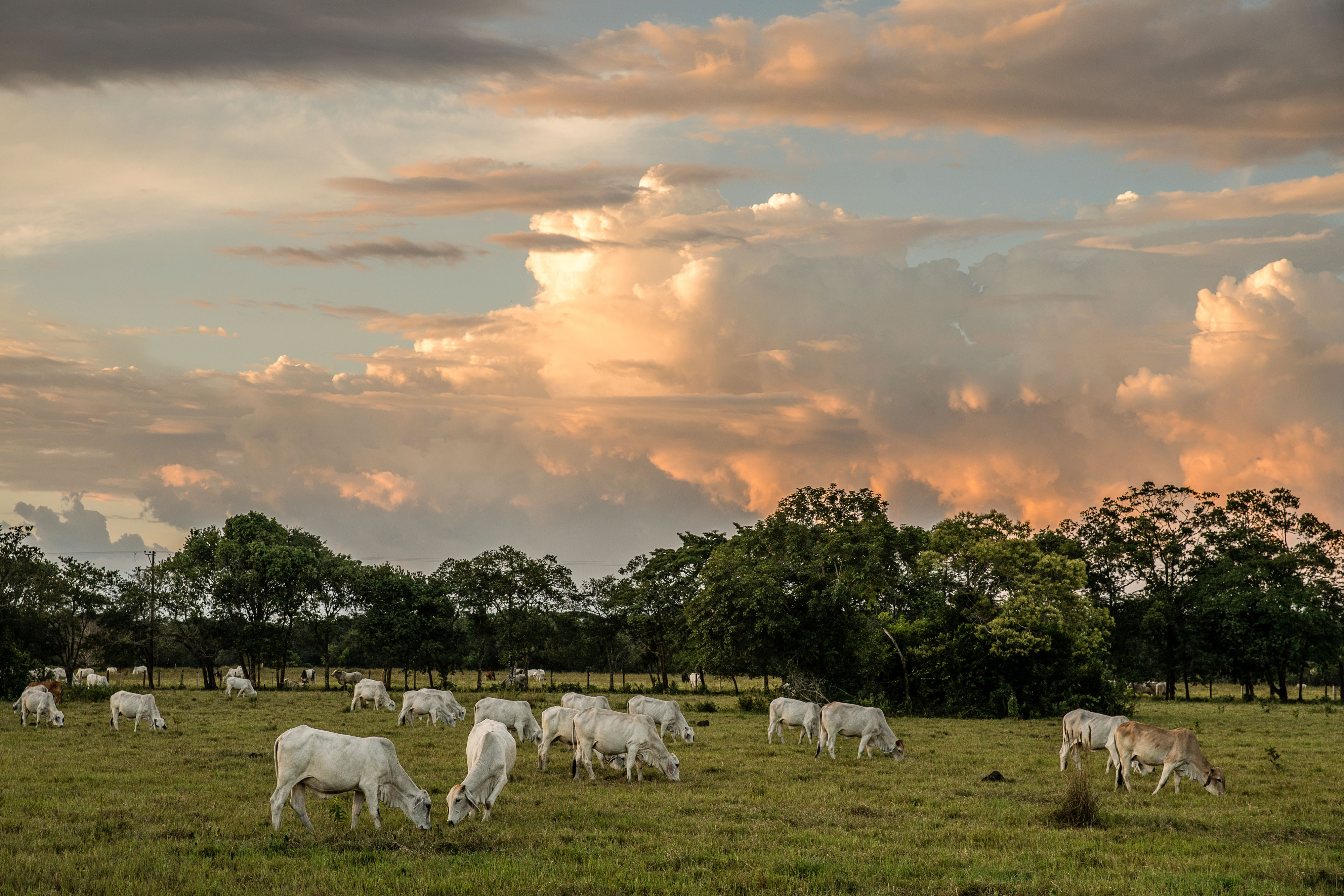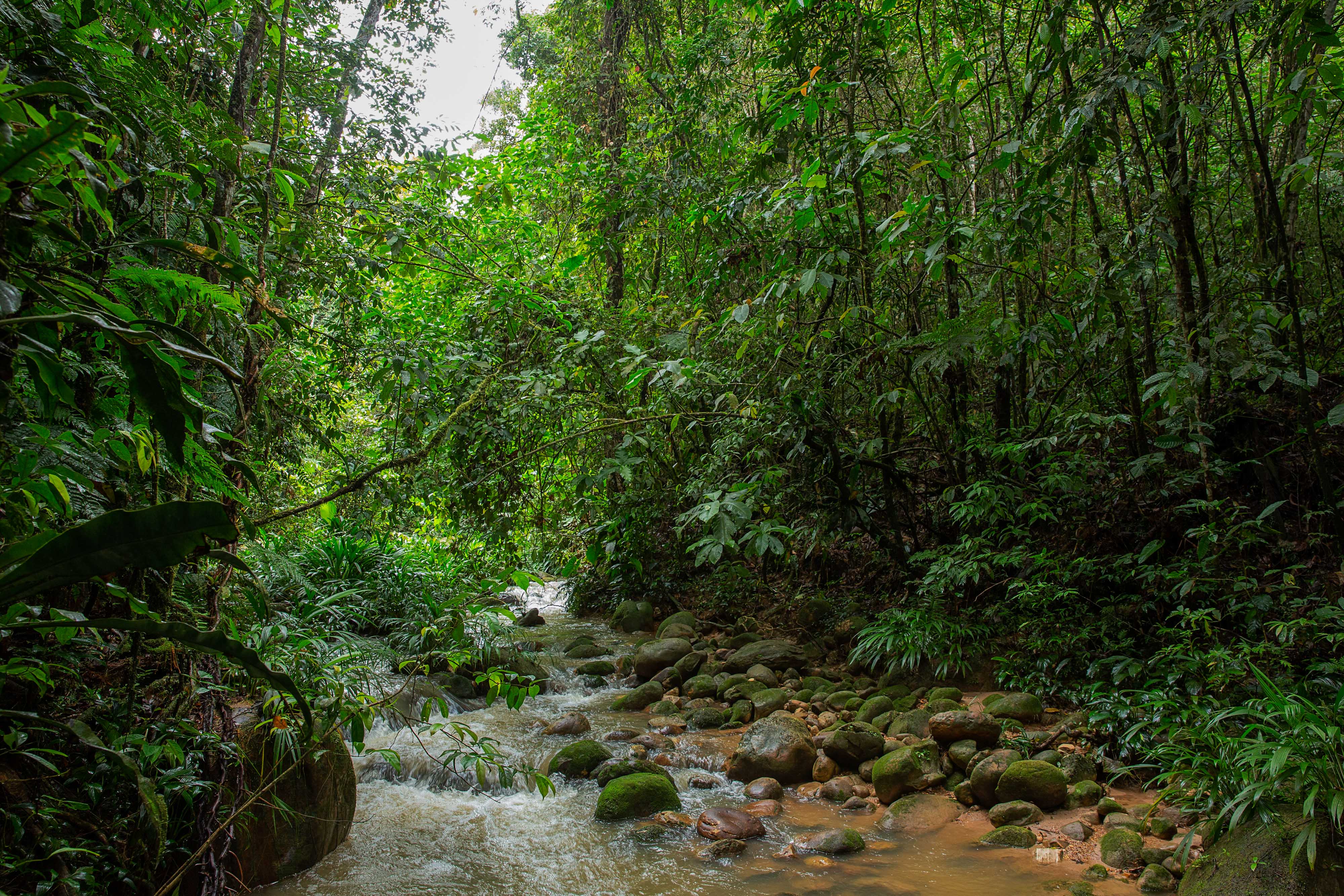Finding Peace
Displaced and disenfranchised by decades of war, some Colombians are rebuilding their lives—and their forests—through ranching.
Summer 2020
One day in 1999, Mercedes Murillo Gutierrez learned the reason her children had not wanted to attend school for several months. Marxist-inspired insurgents of the Revolutionary Armed Forces of Colombia (FARC) had enrolled as students in their school and had begun forcibly recruiting classmates to serve as guerrilla fighters in the country’s civil war. Guerrilla leaders told Murillo that her son and two teenage daughters would be forced to join Front 27 and that she could only keep her youngest daughter, who was 7 years old.
"God gave me the strength to say, ‘Over my dead body you’re taking my [children]!’ And they told me, ‘That’s what we are thinking. We will kill you and take them,’” she recalls. “Today I don’t even understand how I had the strength to say that and do what I did after that.”
The next day she woke up early and walked two hours to the next settlement, where her son was working as a day laborer. She says, “I got there and my son hugged me and said, ‘God bless you, Mother, for coming. They are going to kill me. Let’s go.’
Murillo left the small arepas restaurant she owned and the life she had scratched out as a single mother in Granada, in central Colombia’s state of Meta, rather than risk losing her children. She fled with them to build a new life somewhere else.
The Colombian conflict displaced millions
Murillo’s experience was far from unusual. The armed conflict in Colombia, which continues in certain rural areas today, has displaced some 8 million people. Colombia has the world’s second-highest level of forcible displacement, after Syria.
The war started in Colombia’s jungles during the mid-1960s, following a decade of political violence. For 52 years, the FARC, the National Liberation Army (ELN) and other groups conducted a bloody guerrilla campaign in rural areas, leading ambush attacks on government forces and funding their operations through drug production, taxation and trafficking as well as ransom from kidnappings. During that time, narcotraffickers like the infamous Pablo Escobar also rose to power and added to the chaos.
Even before the war with the FARC started ratcheting down in 2016, the Colombian government—with help from the World Bank, farmers’ groups and other organizations—aimed to improve economic development and education opportunities for its rural poor. In the early 2000s, the government offered displaced Colombians vacant state lands and plots of land on properties it had seized from narcotraffickers and money launderers.
In 2004, Murillo took advantage of the government’s offer and resettled in the rural village of La Guardiana near the small town of San Martín, Meta. When she arrived at her parcel, it was barren scrubland.
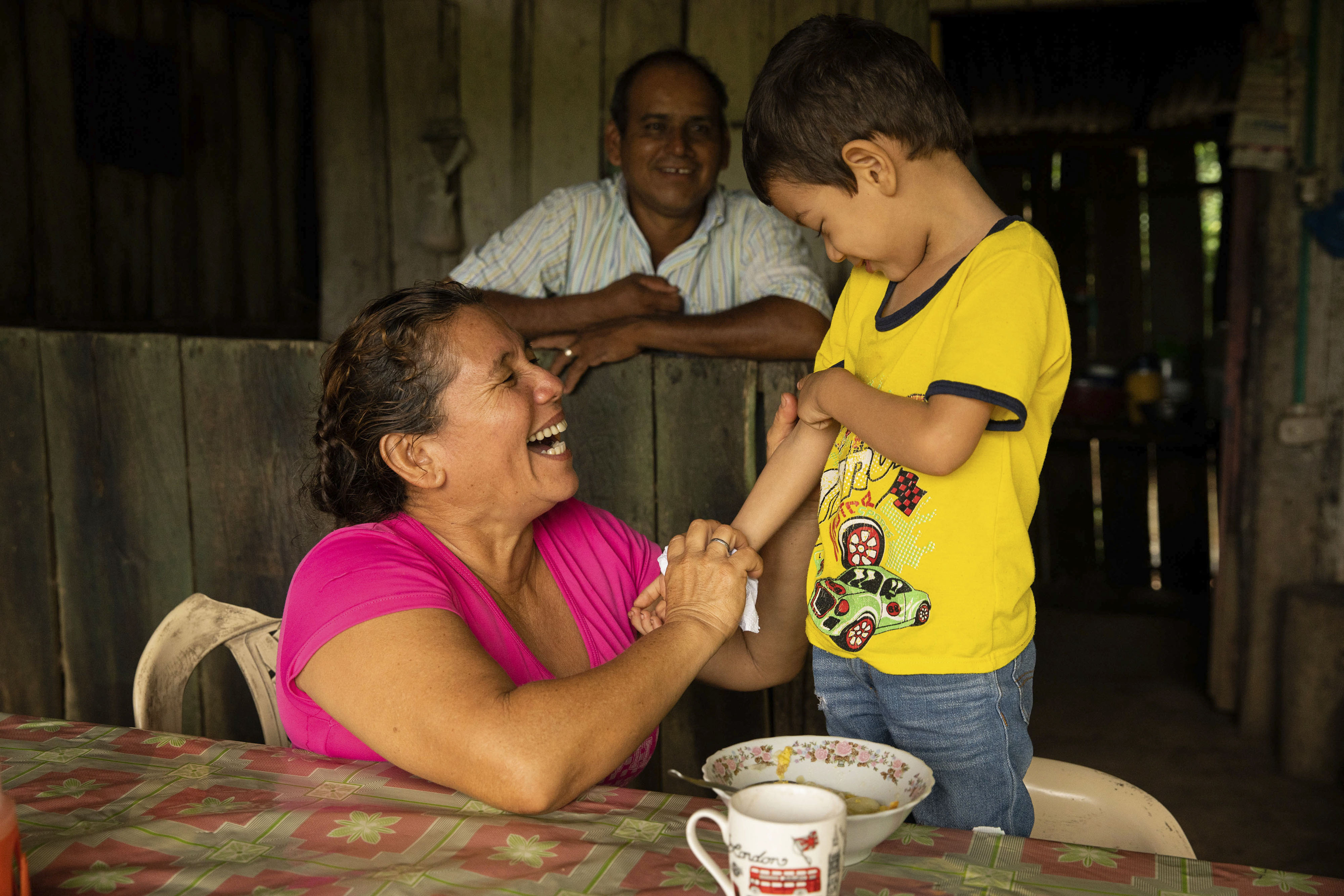
Mercedes Murillo Gutierrez, the Rancher Who Can Finally Dream
Mercedes Murillo Gutierrez reclines in a rocking chair. The 55-year-old mother of four injured her back while lifting a heavy bag of feed for cattle at the end of the dry season—one of the many injuries she’s sustained since starting as a farmhand at the age of seven.
“I have worked my whole life like a man. I got my first pair of shoes, flip-flops, when I started working,” she says, her smile broad. She points to the scars on her foot and arm from that era—scars made from her own mistakes in handling a machete and scars she received from her parents’ punishments. “When I was a girl, I had no dreams,” she says. “I was always hungry. I didn’t go to school. I was always working.”
A mother by age 16, Murillo worked a variety of jobs, including 12-hour shifts as a farm laborer and later as a business owner making arepas. In 1999, three of her four children were about to be forcibly recruited by local guerrillas. She took them and fled to a nearby town, where she worked for a bus company until she received land from the government in 2005.
Owning a farm has not been easy, she says, but she built a life that she could never hope for as a girl. Initially, her scrub grass couldn’t support cattle, but when the sustainable cattle-ranching program began its second phase in 2012, Murillo started attending meetings and learned how to improve her operation. She eventually joined the program, promising to keep a portion of her land in natural vegetation in exchange for financial assistance and technical advice. She received electric fencing to prevent cows from entering streams and to help her rotate them to different pastures before the land became overgrazed. Over the years she has planted thousands of trees and shrubs. So far, half of her land is planted with scattered trees, and it has supported as many as 26 cows, although she believes it has the capacity to feed more if she had the resources to plant more.
The energy she feels when on the ranch is her biggest reward for reforesting her land, says Murillo. She describes the ranch in terms of trees and water, and the settled feeling it has given her. “I will plant trees all my life,” she says.
Today, Murillo’s ranch is filled with shrubs and 2,300 trees that provide shade to her herd of 10 cows. Its pastures are thick with nutritious grasses. The transformation was made possible by an innovative program that marries international development funding with environmental expertise.
Andrés Zuluaga, who leads The Nature Conservancy’s efforts to create sustainable cattle-ranching programs in Colombia, says that the decision to resettle refugees as agriculturalists was meant to create stability, but putting thousands of untrained farmers and ranchers onto plots of degraded land without education or help has created some problems. It pushed agriculture into Colombia’s forests and grasslands. Converting wild lands into pastures and putting cows on poorly tended fields led to loss of wildlife habitat, and overgrazing created soil erosion and runoff that clogs rivers.
Now TNC, the government and the ranchers themselves are trying to fix the situation, by working to make their ranches sustainable and more productive at the same time.
Refugees learn sustainable cattle ranching
Zuluaga bounces on the seat of a white four-wheel-drive pickup truck as it navigates a rutted dirt road outside of San Martín, Meta. A tall, wide-shouldered driver—a former Bogotá police officer—steers them through a tunnel of trees. The driver pauses to snap photos from his smartphone mounted to the dashboard. He sends the pictures to his mother back in the city because he wants her to see how deep into the jungle they are traveling.
Encompassing the confluence of the Amazon rainforest, the foothills of the Andes Mountain Range and the eastern Orinoco High Plains, Meta is home to one of the planet’s most biodiverse ecosystems—rich in forests, with plenty of water and productive soil. In rural places, it’s common to see flocks of parrots or squirrel monkeys or to hear howler monkeys. In the early 2000s, this Garden of Eden was largely ruled by paramilitaries, and during the conflict, the area became a spoil of war where illicit crops like coca helped finance the growth of armed groups.
Even though the FARC entered a peace agreement with the government of Colombia in 2016, highly organized criminal gangs and dissident factions of the FARC still operate south of here, where illegal coca cultivation is prominent. The countryside can be a dangerous place to work. Violence displaced at least 39,000 people in the country in 2019 and continues to shape rural life.
Zuluaga is heading to Blanca Raquel Guerrero’s 50-acre farm, which is a learning center of sorts for other ranchers in the area. Like Gutierrez, Guerrero escaped guerrilla violence. In the middle of one night in December 1998, a pregnant Guerrero fled on foot with her husband and young children over a mountain and along a river, reaching the relative safety of San Martín by dawn. Years later, the government awarded Guerrero land formerly owned by narcotraffickers.
When she arrived at the farm she calls Sión (Zion), it was barren scrubland with no trees. She received one cow from a government program to start. “We had no food,” she says. Using what little money she brought with her and plants she obtained through farm programs, she planted citrus, mango and cashew trees, among other crops, to feed her family while also raising cattle for dairy and meat. Over the next several years, Hernandez raised up to 10 cows that grazed on the scrubby grasses. But each summer the grasses withered in the hot sun, the well ran dry, and some cattle died. Even though the cattle roamed on 50 acres—5 acres per cow—the land did not supply enough forage to sustain them.
Everything changed in 2012. Guerrero, Murillo and others in the community heard about a meeting to share a new strategy for cattle ranching. It promised to help new ranchers make the most of their modest operations by leveraging nature and forests to make their ranches more productive for grazing.
Zuluaga and other conservationists are trying to help ranchers adopt a system called silvopastoral field management. It’s a grazing and conservation strategy that can raise healthier cattle and pastures while supporting larger herds. This is done by planting a combination of forage grasses, herbs, shrubs and trees. The animals grazing this mix get more food per acre than with grass alone, so larger herds thrive on fewer acres. The shade of trees reduces the effects of heat stress—and increases milk production. These gains allow the ranchers to set aside land for conservation without reducing their overall income.
In 2012, Guerrero joined the Colombia Mainstreaming Sustainable Cattle Ranching Project, a joint venture of the World Bank financed by the Global Environment Facility and the government of the United Kingdom. Murillo followed suit in 2015. The Colombian national cattle ranching association FEDEGAN leads the project with three Colombia-based partners: The Nature Conservancy, the Center for Research on Sustainable Agriculture Production Systems and Fondo Acción. In five regions throughout Colombia, the Silvopastoral Program provides professional training to ranchers in facets of the sustainable ranching strategy, including how to grow trees in a row to create live fences, dapt the mix of plants to local soils and set up solar pumps to supply water to livestock in the fields.
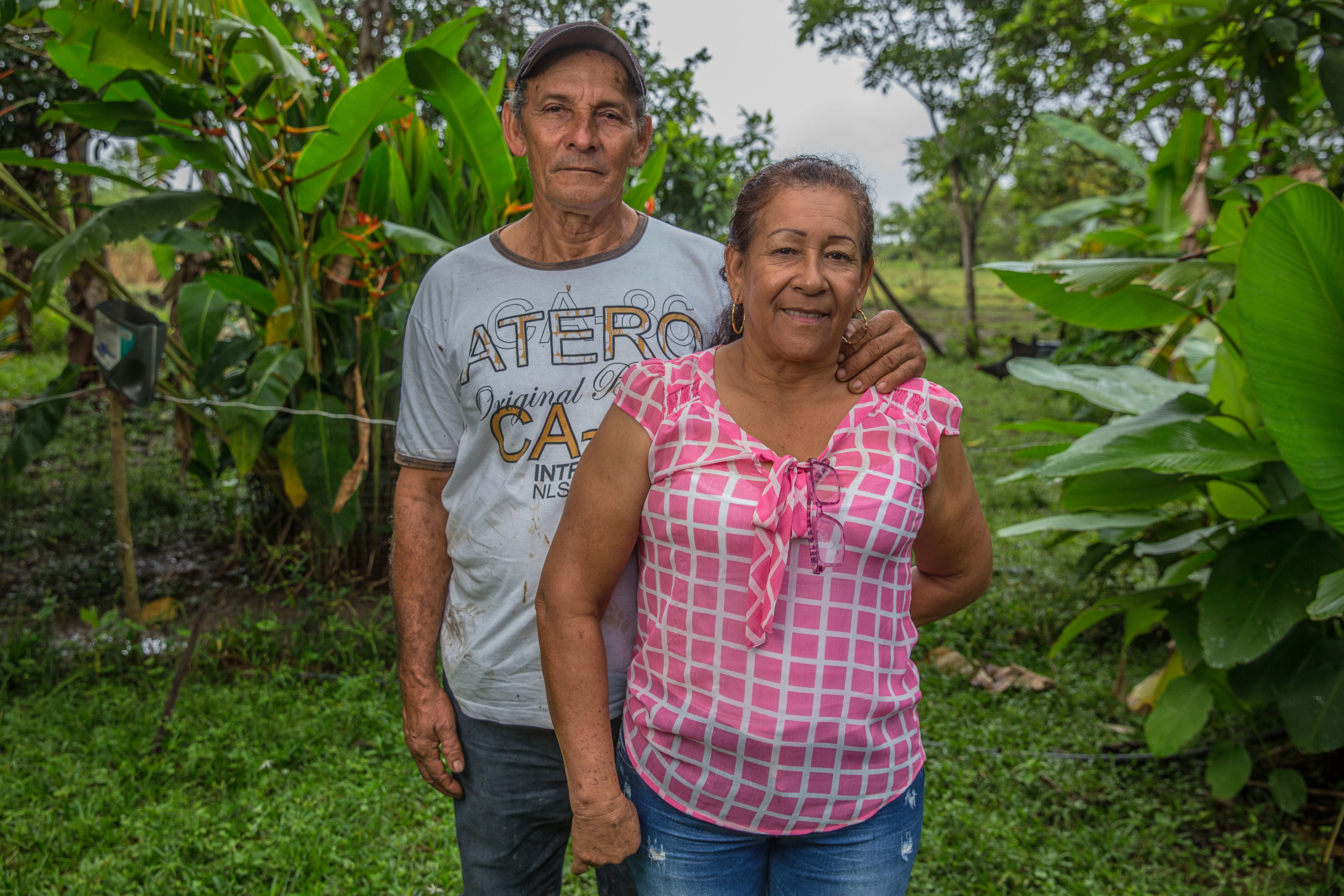
Roxana Adamen Hernandez and Edilson Ortiz Arango, the Family That Started Over From Scratch
Roxana Adamen Hernandez walks a hedgerow of native trees strung with electric fencing and flashes a smile to her husband, Edilson Ortiz Arango. He reaches for her hand and then uses a stick to lift a stretch of electric fence for her to pass into the pasture. They are near the spot where they restarted their lives in Meta after being displaced by war.
Fifteen years ago, when they arrived at the farm they now call La Bendición (The Blessing), they first pitched camp on the land several yards up from a small stream at the far corner of their nearly 50-acre plot, close to what is now a large mango tree. Adamen mimes the dimensions of their first shelter, which consisted of a plastic tarp roof and canvas walls.
“I cried as soon as I got here and saw the conditions,” says Adamen. “It was so hot. We had no water. We had no bathroom. It was so difficult.” But, she adds, it was finally home for the couple and their nine children. “And we are all alive,” says Ortiz.
While previously living in Vista Hermosa, Meta, Ortiz received threats that guerrillas would come for him if he did not join the armed conflict. He had five days to join the group or become a military target. A neighbor’s 12-year-old son had been taken into the group not long before and died almost immediately in the war. “First they will come for me, and next it will be our boy,” he recalls. The couple made the decision to leave, although they lost everything, including a herd of 45 cows and their home.
Following several years of being displaced, the family eventually resettled on nearly 50 acres given to them by the government. Over time, the couple earned enough to buy their own cows. Today, they raise their herd of 16 cows in a silvopastoral system of approximately 2,300 scattered trees, and hedgerows of perennial plants and fodder crops.
Most of the family’s children have moved to nearby towns. Their daughter urges them never to sell the farm. When she comes to visit with her family, she pitches a tent and camps next to the farmhouse Adamen and Ortiz eventually built.
“Thank God we are all still alive,” says Adamen. “Had we not come here, the story would be different. That is the blessing. We started from scratch. God has rewarded us with this piece of land.”
“Cattle ranching has already been scaled up badly in Colombia and has resulted in extensive deforestation,” says spatial ecologist Silvia Alvarez, sustainable landscapes coordinator for the Wildlife Conservation Society in Colombia. That’s why efforts to convert open grazing land into silvopastoral systems are emerging in strategic locations.
In exchange for training, “ranchers sign a conservation agreement to protect forest or wetlands on the farm. And in the grazing area, [they plant] trees and shrubs that serve as forage for the cattle,” Zuluaga says. Ranchers work with the silvopastoral initiative to restore forests, create wildlife corridors and create buffers on their land to reduce the amount of sediment that enters local streams.
“These ranchers have learned to protect land, promote productivity of dairy cattle and increase connectivity in agricultural landscapes,” says Zuluaga. “Their trees and plants become steppingstones for biodiversity to create a mosaic of natural areas.”
As ranchers become better land stewards, their properties grow a wide array of trees and plants, which also support wildlife. And if this process can be repeated across thousands of the country’s ranches, then it will rebuild a mosaic of forests that had been cut down.
But getting farmers and ranchers, who already live on thin profits, to invest money in their land often takes some convincing.
Ranchers receive financial support to transform their pastures
Although many people associate Colombian agriculture with coffee, says Zuluaga, cattle actually occupy 80% of the country’s agricultural land, taking up about 88 million acres. With an average of one cow per 3.5 acres, conventional cattle ranchers need large pastures just to subsist.
Guerrero is a local community leader among displaced people, and she often invites others to her farm to learn from one another. Many, like her, had rural upbringings but did not learn how to manage herds of livestock or run a farm.
Farmers and ranchers who visit Guerrero’s operation get to see her progress. So far, she has planted 6,000 trees, among them species like yopo and bucaro, which provide nitrogen to the soil and support animal nutrition. She has established vast swaths of perennial forage plants, including the botón de oro (golden button), which has bright yellow flowers, and she has planted a mix of grasses that grow as high as her shoulder when cattle are rotated to graze other parts of the pasture.
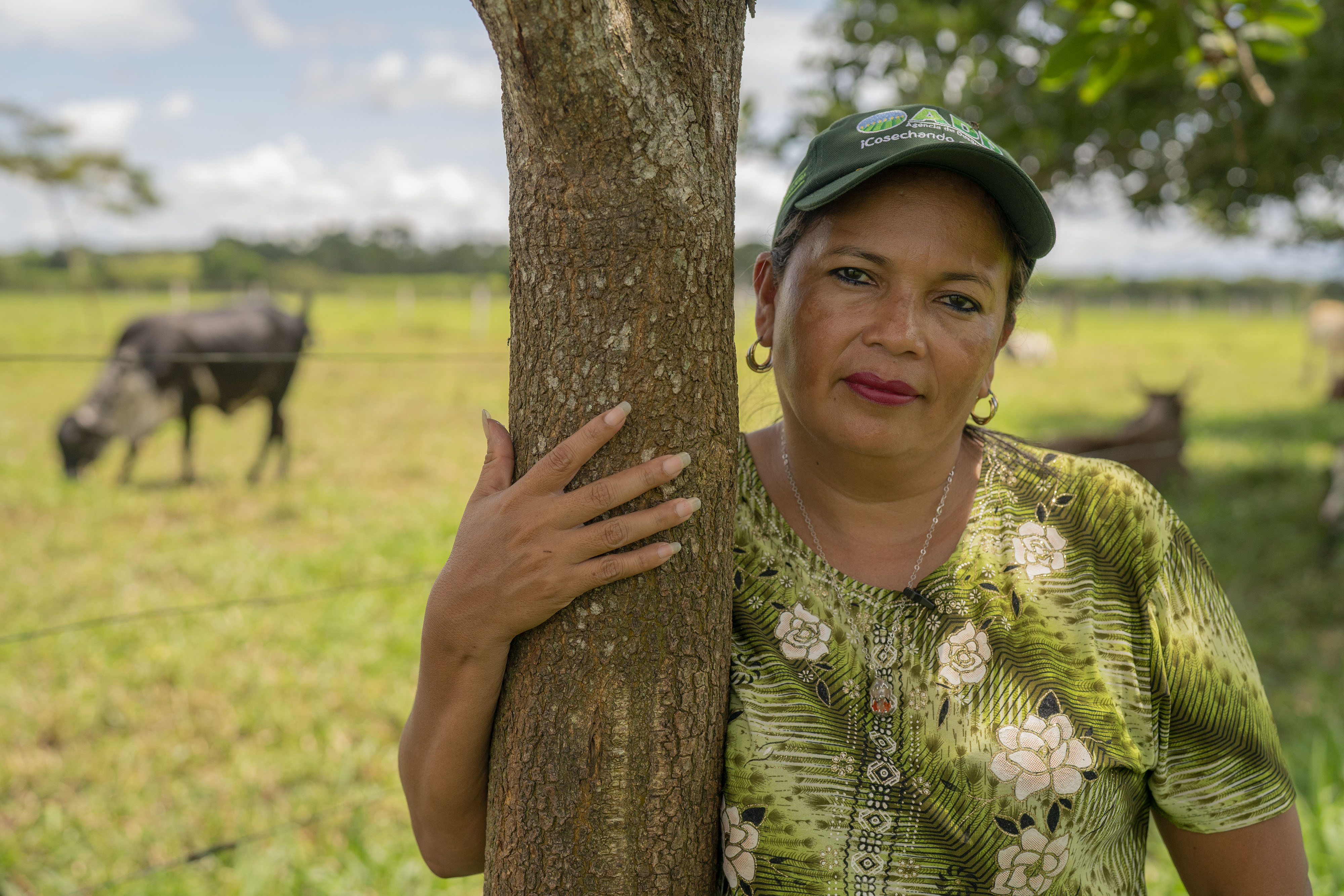
Blanca Raquel Guerrero, the Leader Who Rebuilt Her Life
Blanca Raquel Guerrero fled from her home in Puerto Toledo, Meta, in the middle of the night in December 1998. Pregnant and on the run with her three small children and husband, Guerrero and her family escaped after they became a target of local guerrillas. A unit of the Colombian army had camped next to her farm, which made the guerrillas suspicious. Within an hour of the army’s departure, one guerrilla tipped her off to the threat. So the family fled, carrying what they could. They walked all night, traversing a mountain and wading down the Ariari River. At dawn, their path intersected with the army, which helped them reach safety in the nearby town of San Martín.
When they were living in Puerto Toledo, Guerrero and her husband had a farm that raised a couple of cattle for milk, but their cash crop was coca. “In that region, there are no roads, no education, nothing,” she says. That also meant there was no law. “It was me, myself and me again,” says Guerrero. A bag of coca leaves sold to local buyers sustained the family.
Even though the war has officially ended, violence is still common in rural areas. Guerrero’s former neighbors in Meta were recently murdered. “I belong to the group of victims that feel the peace process is not real,” she says.
Today, long divorced and the mother of five children between the ages of 15 and 27, Guerrero is head of her household, and she has rebuilt her life “physically, psychologically and morally,” she says.
At the heart of that transformation is the approximately 50-acre farm she now owns along a rutted gravel road outside of San Martín, in the biologically rich Orinoquia region where the foothills of the Andes meet tropical grassland plains. The government eventually provided her this plot, which was once owned by narcotraffickers. When she arrived in 2004, the parcel was barren scrubland and had no trees. She had one cow and no food. Gradually, she planted approximately 6,000 trees; added nutritious grazing plants for a herd that now numbers 17 cows, which she raises for dairy and meat; built a fishpond; and learned about more resources to empower women and to build a sustainable ranch. “It is really up to ourselves to build meaningful lives,” she says.
Guerrero’s children still live with her, although they study in the local town, and they help on the farm. “When they come back to the farm, they change completely,” she says. It’s peaceful and the air is clear, she notes. “We have health, and the personal satisfaction—not an obligation but a need—we have to give back to the environment.”
Now, her plot contains both forest and pasture, which supports 17 head of cattle because “there is now a lot to feed them,” she says. Compared with other ranches in the area that have been grazed down to bare ground, Guerrero’s pasture is filled with dense layers of greenery, has richer soil, is full of birds and is frequented by rainforest mammals. “When I arrived, the only trees we could see were in the distance on the foothills.” Today, orchards of mango and citrus trees surround her house. Trees are scattered throughout the wide pastures, which are filled with rows of tall shrubs and thick emerald grasses.
Murillo’s experience has been similar. Before the program, her ranch had rock-hard soil and short grass that couldn’t support cattle in the dry season. Some cows died. After five years of trial and error, she was open to new ideas about planting trees and shrubs. Her neighbors were incredulous. “They wondered what my cows were going to eat,” she says. “When I saw the benefits to the cows and to the land, I thought the project was excellent and went ahead with it.”
So far, more than 44,000 acres of forests across Colombia have been protected by conservation agreements, and 94,864 acres of barren pasture have been transformed by planting 3.1 million trees.
The farmers also receive technical assistance and low-interest loans to buy the shrubbery needed. The program provides electric fencing to divide pastures and move cattle to new fields, as well as hoses and pumps to bring water to the cattle rather than leading the animals to streams where they would trample riverbanks and contaminate water. The local electricity supply is poor, and the project helped Guerrero install solar panels to operate the electric fencing and water pumps for the herd. “These are vital things for us,” she says. “We don’t care if we’re in the dark at night, but the cows need water.” The program even advises ranchers on which bovine medications could be detrimental to the surrounding biodiversity.
Guerrero is among the 1,866 producers who receive payments from program funding that cover up to 15% of the total costs to transform their farms. There are about 60 other demonstration farms like Guerrero’s and Murillo’s across Colombia that provide mentorship and host individual and group training sessions.
Biodiversity monitoring on silvopastoral systems in South America has registered more than a 30% increase in bird species. “The silvopastoral systems are important steppingstones for birds migrating to and from the different patches of forests,” says Zuluaga. He adds that improving biodiversity helps ranches and farms because it attracts more animals and insects that pollinate plants and eat and disperse seeds.
Farms provide a sustainable livelihood to thousands of refugees
In some areas Zuluaga has worked, like the Amazon, illicit activities such as growing coca crops are common. “People are used to receiving money easy,” he says. “If the people don’t have other options, they don’t change. They need to live.” The farms provide a source of income and sustainable livelihoods to the people affected by Colombia’s conflict, he says.
In Meta, 684 cattle ranchers joined the sustainable cattle-ranching program. To date, a total of 4,100 ranchers nationwide have joined it, while 24,416 have been trained and are implementing it without receiving ongoing support.
Today, Guerrero’s ranch is doing better than ever, and the restoration of forests has aided in the return of many species of birds. Her property is a gathering place for local ranchers to discuss issues that might improve their livelihoods.
“To me, I’m at peace when I’m on my farm,” Guerrero says, sitting on her covered patio that overlooks her pasture and forest. “I feel as though I’ve amounted to something.”
Get the Magazine
Become a member of The Nature Conservancy and you'll receive the quarterly print magazine
Subscribe now